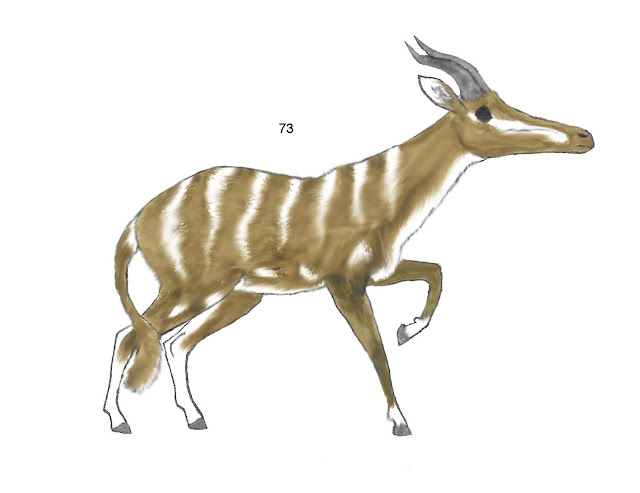 |
| Altiperonoceros gammacornis. |
 |
| Altocephalus saddi. |
 |
| Argus sp.: 3. A. argus; 4. A. contubernalis. |
 |
| Azema sp.: 5. A. siberica; 6. A. melomedius; 7. A. chamma; 8. A. europaeus; 9. A. jonasseni; 10. A. mccoyi; 11. A. succingulum; 12. A. steini; 13. A. perspectus; 14. A. praecursor. |
 |
| Camelidorcas lambeonotus. |
 |
| Castratragus sp.: 16. C. nidius; 17. C. lyranotus; 18. C. blandoni; 19. C. cephalothrix; 20. C. carteri; 21. C. saltana; 22. C. grandiceros. |
 |
| Controcephalus alienus. |
 |
| Cornudens sp.: 24. C. horridus; 25. C. rastrostrius; 26. C. vulgaris. |
 |
| Cyrtonoceros elaphas. |
 |
| Dagera pentaceros. |
 |
| Dakpil sp.: 29. D. rufus; 30. D. longicollis; 31. D. gazella; 32. D. boylei; 33. D. bledsoei; 34. D. aurifrons; 35. D. aquaticus. |
 |
| Diairoceros sp.: 36. D. dichotomus; 37. D. monticola; 38. D. sylvicultor. |
 |
| Eburneaceros sp.: 39. E. elatior; 40. E. hahni. |
 |
| Enrenoceros moustaci. |
 |
| Fovea bombysacaci. |
 |
| Gelada sp.: 43. G. geneiada; 44. G. taurus; 45. G. phluarus; 46. G. gelada; 47. G. bubalinus. |
 |
| Ghigul sp.: 48. G. cautes; 49. G. insulto; 50. G. ovis; 51. G. laniger; 52. G. schirmeri; 53. G. aegoceros. |
 |
| Grandidorcas roeselmivi. |
 |
| Hamatilis sp.: 55. H. quadrodens; 56. H. humilis; 57. H. gualama. |
 |
| Hebecephalus montanus 58a. female. 58b. male. |
 |
| Hemidama proboscidus 59a. male. 59b. female. |
 |
| Hippidorcas longicaudatus. |
 |
| Hydrokobus suella. |
 |
| Kaela longicaudis. |
 |
| Lawrencia sp.: 63. L. centralis; 64. L. californicus; 65. L. gattoi; 66. L. crinifrons; 67. L. nessi; 68. L. hippiurus. |
 |
| Lenonia sp.: 69. L. howiei; 70. L. montanus; 71. L. parva; 72. L. waughi. |
 |
| Lepidonasus lemuriensis. |
 |
| Macrotraga acroceratops. |
 |
| Megacyrtonoceros ischupus. |
 |
| Megalodorcas sp.: 76. M. palaceros; 77. M. giganteus; 78. M. borealis; 79. M. antarctica. |
 |
| Mesoceratis sp.: 80. M. ceras; 81. M. dromadarius; 82. M. gazella. |
 |
| Miocapria sp.: 83. M. ammon; 84. M. aires; 85. M. europaeus; 86. M. shawi; 87. M. pyrenaica; 88. M. cylindricornis. |
 |
| Miocopuroceros depressicornis. |
 |
| Moschoryx indica. |
 |
| Notolophus sp.: 91. N. browni; 92. N. diadema; 93. N. melodorcas; 94. N. roserostris; 95. N. formosa; 96. N. vukovici; 97. N. wadei. |
 |
| Nyala sp.: 98. N. elaphas; 99. N. gavranichi; 100. N. evansi; 101. N. jubatus; 102. N. lamaroi; 103. N. striatus; 104. N. nyctes; 105. N. nyala; 106. N. rufus. |
 |
| Otopygus sp.: 107. O. murinus; 108. O. stonei; 109. O. donnelyi; 110a. O. isolatus (nose inflated); 110b. O. isolatus (nose deflated); 111. O. luteus; 112. O. acuceros; 113. O. capensis. |
 |
| Peneceros antilopinus. |
 |
| Phyllopes sp.: 115. P. hirsutipes; 116. P. altaica; 117. P. maculeucas; 118. P. mardesichi. |
 |
| Pilitops sp.: 119. P. larvatus; 120. P. hispida; 121. P. irrorata; 122. P. jovai. |
 |
| Pleuraceros sp.: 123. P. hydrodromas; 124. P. lyraceros; 125. P. hydropotes; 126. P. kobinus; 127. P. scambus. |
 |
| Protocornudens pachyceros. |
 |
| Pselocranium megacervix. |
 |
| Quadroculus sp.: 144. Q. matiexodus; 145. Q. silvicultrix. |
 |
| Ropaloceros sp.: 146. R. depressicornis; 147. R. americanus; 148. R. borealis; 149. R. deserta; 150. R. murinus; 151. R. megacerosus. |
 |
| Saxotragus sp.: 152. S. angelimi; 153. S. eustropus; 154. S. pizzolii; 155. S. apotamus; 156. S. oryx. |
 |
| Sphendoneceros sp.: 157. S. mmelodyi; 158. S. redunca. |
 |
| Stemmatragus oryx. |
 |
| Tapiemulus sp.: 160. T. schembrii; 161. T. leptodon; 162. T. minutoides; 163. T. herberti; 164. T. proboscidus; 165. T. porcella; 166. T. dorsalis. |
 |
| Tetraceros sp.: 167. T. africaus; 168. T. duboisi. |
 |
| Trapiceros sp.: 169. T. pressicornis; 170. T. nemus; 171. T. scalpellum; 172. T. praegravis; 173. T. mutationis; 174. T. scaurus; 175. T. depressicornis. |
 |
| Agrophilus sp.: 176. A. agathaumas; 177. A. microcerosus; 178. A. braziliensis; 179. A. rodriguezi; 180. A. acroceras; 181. A. lepidus. |
 |
| Valudorsum sp.: 182. V. minuosa; 183. V. gravum. |
 |
| 184. Kofia verecundus. |
 |
| Siacabra sp.: 185. S. murmurus; 186a. S. thibetanus male, 186b. Female; 187. S. tenuis; 188. S. idonius; 189. S. porcelina; 190. S. tropicalis; 191. S. macdonaldi; 192. S. crocum. |
 |
| Calaqua sp.: 193. C. clamator; 194. C. straminis; 195. C. nilssoni; 196. C. immutatus; 197. C. aridus; 198. C. rettenmundi; 199. C. dupungo; 200. C. cristata. |
 |
| Kusu sp.: 201. K. kusu; 202. K. frenator; 203. K. prorito; 204. K. hammondi; 205. K. plummeri; 206. K. frontalia. |


6 comments:
Fascinating stuff, I would actually be quite interested in having a few of these species in my setting for a novel I intend to do one day, would that be alright with you?
Well I would like to know more about your project.
That's fine is there anyway I can contact you a bit more easily than this?
You can use the "Contact Us" feature. The link is in the sidebar.
Will, please try again. It's still up and running fine now. If it still won't come up for you, then clear your cache files.
Post a Comment